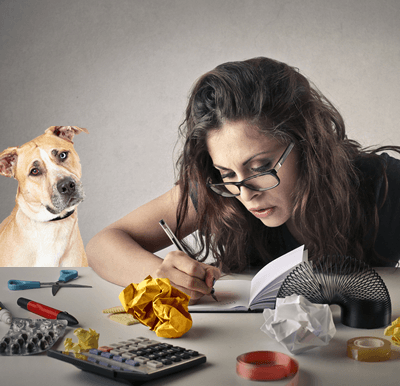You've heard us say it many times I'm sure: training mode is a hoax! That's because dogs are ALWAYS learning. They don't shut off when the bell rings for recess. Their existence and experiences will mould their behaviour. They are learning ALL of the time!
Does that sound exhausting?
We've spent decades refining the training process and while it's important to strap on the bait pouch and do some dog training, what you do outside of 'training mode' is equally important. Dogs need a lot of successful repetition in any skill across multiple environments to truly understand what we expect from them. That could really eat up your time, but there are some EASY ways to get in more reps outside of your formal training sessions.
The added benefit to reinforcing your dog's training in their day-to-day life is that they'll learn to listen to you all of the time, not just when you're in training mode.
So, what are these easy ways to train we're talking about? Let's jump in!
Make it Part of Your Day
Often, we don't have a big chunk of time to train. Life is busy and when we don't have enough time, the dog might not get their training lessons. The good news is, you don't have to head out for a 45-minute training session to get in enough training. Dogs commit to memory as they sleep, just like we do. The more you can train short sessions through the day, the more opportunity your dog will have to generalize listening and commit lessons to long term memory.
The 5-minute training session is of GIANT benefit in training your dog!
Take a look at your daily life. What are some of your common routines that are a part of each day? What do you do when waiting for the coffee to brew? You could stand yawning at the counter or you could work some counter surfing drills with your dog.
What do you do when the commercials come on during your favourite shows? You could zone out for 2 minutes and 2 seconds, or you could train some response to name with your dog.
Think about other times throughout your day where you have a few minutes to train? Maybe you have to wait at the end of the driveway with the kids for the school bus each day. What kind of training could you do while you wait? Just having your dog sit calmly with you as you wait will add pennies to their training banks.
Don't underestimate the power of a short training window - it all adds up and will help your dog generalize their listening skills.
Rituals and Routines
Another place where it's really easy to reinforce and strengthen your dog's skills is in your daily rituals and routines. Things like the way we set out on walks and rituals around feeding time, or release from the crate can be a huge asset when used right in training.
In this trainer's opinion, there are 2 main components to rituals: the expectations you set and the energy you reward.
The Expectations You Set
This is what you expect from your dog every time you practise a ritual. For example, do you expect them to be polite and mannerly during the ritual or do you let them decide for themselves? Is it okay for them to dance around you and crash through the door to get outside or do you expect them to sit calmly until they're released?
Do you remember sitting at your desk in Grade school trying to be as good as gold so the teacher would let you out? When the quietest row was the one that was released first for recess or home time? This ritual helps kids practise control and manners. You can be wild, but you have to have self-control first! Our dogs need to practise the same thing.
So, is your expectation that they can leap at the food bowl as you put it down or do they have to rehearse sitting calmly until you release them to eat?
The Energy You Reward
Remember that rewards are ANYTHING the dog wants and finds positively reinforcing. They don't have to come from you. Reinforcements will frequently come from the environment in the form of natural rewards. Pulling, sniffing, lunging out the door - these are all very self-rewarding behaviours for most dogs. If your dog is pulling you out the door with their nose glued to the ground at the start of each walk, they're being rewarded in abundance by the environment. The more a behaviour is rewarded, the stronger it will become for the dog.
Setting out for your walk in this manner will ensure future walks have the same feelings of frustration. Rehearsal predicts behaviour.
What if the rewards come from you instead of the environment? What if they came for being mannerly rather than rude? The heavily rewarded behaviour will override the environmental rewards if you consistently reinforce what YOU want rather than what the dog naturally wants.
The ritual is a great place to train your dog!
Start with manners before you head out for your walk. Not only will this give you a chance to rehearse good behaviour as part of your ritual, it will set the tone for your outing as well.
If you start the walk with your dog's energy under control and help them practise calm before your outings, this will become the rehearsed behaviour and the habit.
Other ideas for training rituals include releasing them from the house to the yard: do they crash through the door or wait for the okay from you? When you remove the leash of the trained dog to offer freedom, do they dash off as soon as you unclip or wait for you to release them first?
What other rituals in your day could you use to boost your training efforts without taking too much time? Write them down and put them into play! They will serve your training more than you know.
Until next time,
Happy Training!

